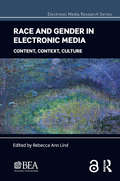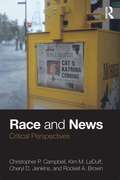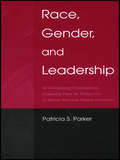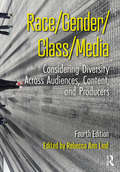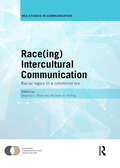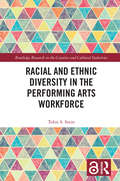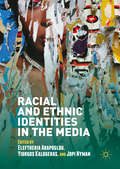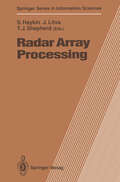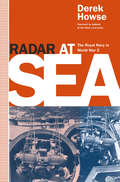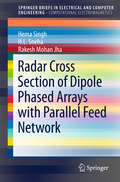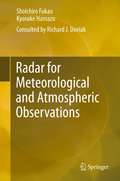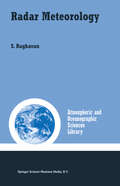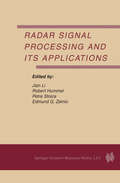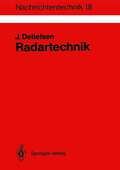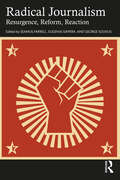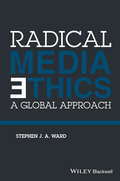- Table View
- List View
Race and Gender in Electronic Media: Content, Context, Culture (Electronic Media Research Series)
by Rebecca Ann LindThis volume examines the consequences, implications, and opportunities associated with issues of diversity in the electronic media. With a focus on race and gender, the chapters represent diverse approaches, including social scientific, humanistic, critical, and rhetorical. The contributors consider race and gender issues in both historical and contemporary electronic media, and their work is presented in three sections: content, context (audiences, effects, and reception), and culture (media industries, policy, and production). In this book, the authors investigate, problematize, and theorize a variety of concerns which at their core relate to issues of difference. How do we use media to construct and understand different social groups? How do the media represent and affect our engagement with and responses to different social groups? How can we understand these processes and the environment within which they occur? Although this book focuses on the differences associated with race and gender, the questions raised by and the theoretical perspectives presented in the chapters are applicable to other forms of socially-constructed difference. Chapters 5, 10, 12, and 19 of this book are freely available as downloadable Open Access PDFs at http://www.taylorfrancis.com under a Creative Commons Attribution-Non Commercial-No Derivatives (CC-BY-NC-ND) 4.0 license.
Race and Gender in Electronic Media: Content, Context, Culture (Electronic Media Research Series)
by Rebecca Ann LindThis volume examines the consequences, implications, and opportunities associated with issues of diversity in the electronic media. With a focus on race and gender, the chapters represent diverse approaches, including social scientific, humanistic, critical, and rhetorical. The contributors consider race and gender issues in both historical and contemporary electronic media, and their work is presented in three sections: content, context (audiences, effects, and reception), and culture (media industries, policy, and production). In this book, the authors investigate, problematize, and theorize a variety of concerns which at their core relate to issues of difference. How do we use media to construct and understand different social groups? How do the media represent and affect our engagement with and responses to different social groups? How can we understand these processes and the environment within which they occur? Although this book focuses on the differences associated with race and gender, the questions raised by and the theoretical perspectives presented in the chapters are applicable to other forms of socially-constructed difference. Chapters 5, 10, 12, and 19 of this book are freely available as downloadable Open Access PDFs at http://www.taylorfrancis.com under a Creative Commons Attribution-Non Commercial-No Derivatives (CC-BY-NC-ND) 4.0 license.
Race And News: Critical Perspectives (PDF)
by Christopher P. Campbell Rockell A. Brown Cheryl D. Jenkins Kim M. LeDuffThe history of American journalism is marked by disturbing representations of people and communities of color, from the disgraceful stereotypes of pre-civil rights America, to the more subtle myths that are reflected in routine coverage by journalists all over the country. Race and News: Critical Perspectivesaims to examine these journalistic representations of race, and in doing so to question whether or not we are living in a post-racial world. By looking at national coverage of stories like the Don Imus controversy, Hurricane Katrina, Barak Obama's presidential candidacy, and even the Virginia Tech shootings, readers are given an opportunity to gain insight into both subtle and overt forms of racism in the newsroom and in national dialogue. The book itself is divided into two sections, with the first examining the journalistic routine and the decisions that go into covering a story with, or without, relation to race. The second section, comprised of case studies, explores the coverage of national stories and how they have impacted the dialogue on race and racism in the United States. As a whole, the collection of essays and studies also reflects a variety of research approaches. With a goal of contributing to the discussion about race and its place in American journalism, this broad examination makes Race and Newsan ideal text for courses on cultural diversity and the media, as well as making it valuable to professional journalists and journalism students who seek to improve their approach to coverage of diverse communities.
Race And News: Critical Perspectives
by Christopher P. Campbell Rockell A. Brown Cheryl D. Jenkins Kim M. LeDuffThe history of American journalism is marked by disturbing representations of people and communities of color, from the disgraceful stereotypes of pre-civil rights America, to the more subtle myths that are reflected in routine coverage by journalists all over the country. Race and News: Critical Perspectivesaims to examine these journalistic representations of race, and in doing so to question whether or not we are living in a post-racial world. By looking at national coverage of stories like the Don Imus controversy, Hurricane Katrina, Barak Obama's presidential candidacy, and even the Virginia Tech shootings, readers are given an opportunity to gain insight into both subtle and overt forms of racism in the newsroom and in national dialogue. The book itself is divided into two sections, with the first examining the journalistic routine and the decisions that go into covering a story with, or without, relation to race. The second section, comprised of case studies, explores the coverage of national stories and how they have impacted the dialogue on race and racism in the United States. As a whole, the collection of essays and studies also reflects a variety of research approaches. With a goal of contributing to the discussion about race and its place in American journalism, this broad examination makes Race and Newsan ideal text for courses on cultural diversity and the media, as well as making it valuable to professional journalists and journalism students who seek to improve their approach to coverage of diverse communities.
Race and News: Critical Perspectives
by Christopher P. Campbell Kim M. LeDuff Cheryl D. Jenkins Rockell A. BrownThe history of American journalism is marked by disturbing representations of people and communities of color, from the disgraceful stereotypes of pre-civil rights America, to the more subtle myths that are reflected in routine coverage by journalists all over the country. Race and News: Critical Perspectives aims to examine these journalistic representations of race, and in doing so to question whether or not we are living in a post-racial world. By looking at national coverage of stories like the Don Imus controversy, Hurricane Katrina, Barak Obama's presidential candidacy, and even the Virginia Tech shootings, readers are given an opportunity to gain insight into both subtle and overt forms of racism in the newsroom and in national dialogue. The book itself is divided into two sections, with the first examining the journalistic routine and the decisions that go into covering a story with, or without, relation to race. The second section, comprised of case studies, explores the coverage of national stories and how they have impacted the dialogue on race and racism in the United States. As a whole, the collection of essays and studies also reflects a variety of research approaches. With a goal of contributing to the discussion about race and its place in American journalism, this broad examination makes Race and News an ideal text for courses on cultural diversity and the media, as well as making it valuable to professional journalists and journalism students who seek to improve their approach to coverage of diverse communities.
Race and News: Critical Perspectives
by Christopher P. Campbell Kim M. LeDuff Cheryl D. Jenkins Rockell A. BrownThe history of American journalism is marked by disturbing representations of people and communities of color, from the disgraceful stereotypes of pre-civil rights America, to the more subtle myths that are reflected in routine coverage by journalists all over the country. Race and News: Critical Perspectives aims to examine these journalistic representations of race, and in doing so to question whether or not we are living in a post-racial world. By looking at national coverage of stories like the Don Imus controversy, Hurricane Katrina, Barak Obama's presidential candidacy, and even the Virginia Tech shootings, readers are given an opportunity to gain insight into both subtle and overt forms of racism in the newsroom and in national dialogue. The book itself is divided into two sections, with the first examining the journalistic routine and the decisions that go into covering a story with, or without, relation to race. The second section, comprised of case studies, explores the coverage of national stories and how they have impacted the dialogue on race and racism in the United States. As a whole, the collection of essays and studies also reflects a variety of research approaches. With a goal of contributing to the discussion about race and its place in American journalism, this broad examination makes Race and News an ideal text for courses on cultural diversity and the media, as well as making it valuable to professional journalists and journalism students who seek to improve their approach to coverage of diverse communities.
Race, Gender, and Leadership: Re-envisioning Organizational Leadership From the Perspectives of African American Women Executives (Routledge Communication Series)
by Patricia S. ParkerMuch has been written about a model of leadership that emphasizes women's values and experiences, that is in some ways distinct from male models of leadership. This book redirects the focus to a view of leadership as a multicultural phenomenon that moves beyond dualistic notions of "masculine" and "feminine" leadership, and focuses more specifically on leadership as the management of meaning, including the meanings of the notion of "organizational leader." This volume focuses on leadership "traditions" revealed in the history of Black women in America and exemplified in the leadership approaches of 15 African American women executives who came of age during the civil rights and feminist movements of the 1960's and 1970's and climbed to the top of major U.S. organizations. It advances a vision of organizational leadership that challenges traditional masculine and feminine notions of leadership development and practice, providing insights on organizational leadership in the era of post-industrialization and globalization. Additionally, by placing African American women at the center of analysis, this book provides insights into the ways in which race and gender structure key leadership processes in today's diverse and changing workplace. It is a must-read for scholars and researchers in organizational communication, management, leadership, African American studies, and related areas.
Race, Gender, and Leadership: Re-envisioning Organizational Leadership From the Perspectives of African American Women Executives (Routledge Communication Series)
by Patricia S. ParkerMuch has been written about a model of leadership that emphasizes women's values and experiences, that is in some ways distinct from male models of leadership. This book redirects the focus to a view of leadership as a multicultural phenomenon that moves beyond dualistic notions of "masculine" and "feminine" leadership, and focuses more specifically on leadership as the management of meaning, including the meanings of the notion of "organizational leader." This volume focuses on leadership "traditions" revealed in the history of Black women in America and exemplified in the leadership approaches of 15 African American women executives who came of age during the civil rights and feminist movements of the 1960's and 1970's and climbed to the top of major U.S. organizations. It advances a vision of organizational leadership that challenges traditional masculine and feminine notions of leadership development and practice, providing insights on organizational leadership in the era of post-industrialization and globalization. Additionally, by placing African American women at the center of analysis, this book provides insights into the ways in which race and gender structure key leadership processes in today's diverse and changing workplace. It is a must-read for scholars and researchers in organizational communication, management, leadership, African American studies, and related areas.
Race/Gender/Class/Media: Considering Diversity Across Audiences, Content, and Producers
by Rebecca Ann LindRace/Gender/Class/Media considers diversity in the mass media in three main settings: Audiences, Content, and Production. It brings together 53 readings—most are newly commissioned for this edition—by scholars representing a variety of social science and humanities disciplines. Together, these readings provide a multifaceted and often intersectional look at how race, gender, and class relate to the creation and use of media texts as well as the media texts themselves. Designed to be flexible in the classroom, the book begins with a detailed introduction to key concepts and presents a contextualizing introduction to each of the three main sections. Each reading contains multiple It’s Your Turn activities to foster student engagement and which can serve as the basis for assignments. The book offers a list of resources—books, articles, films, and websites—that are of value to students and instructors. Several alternate Tables of Contents are provided as options for reorganizing the material and maximizing the flexibility of the readings: by site of struggle (gender, race, class), by medium (television, print, digital, etc.), and by arena (journalism, entertainment). This volume is an essential introduction to interdisciplinary studies of gender, race, and class across mass media.
Race/Gender/Class/Media: Considering Diversity Across Audiences, Content, and Producers
by Rebecca Ann LindRace/Gender/Class/Media considers diversity in the mass media in three main settings: Audiences, Content, and Production. It brings together 53 readings—most are newly commissioned for this edition—by scholars representing a variety of social science and humanities disciplines. Together, these readings provide a multifaceted and often intersectional look at how race, gender, and class relate to the creation and use of media texts as well as the media texts themselves. Designed to be flexible in the classroom, the book begins with a detailed introduction to key concepts and presents a contextualizing introduction to each of the three main sections. Each reading contains multiple It’s Your Turn activities to foster student engagement and which can serve as the basis for assignments. The book offers a list of resources—books, articles, films, and websites—that are of value to students and instructors. Several alternate Tables of Contents are provided as options for reorganizing the material and maximizing the flexibility of the readings: by site of struggle (gender, race, class), by medium (television, print, digital, etc.), and by arena (journalism, entertainment). This volume is an essential introduction to interdisciplinary studies of gender, race, and class across mass media.
Race(ing) Intercultural Communication: Racial Logics in a Colorblind Era
by Dreama G. Moon and Michelle A. HollingRace(ing) Intercultural Communication signals a crucial intervention in the field, as well as in wider society, where social and political events are calling for new ways of making sense of race in the 21st century. Contributors to this book work at multiple intersections, theoretically and methodologically, in order to highlight relational (im)possibilities for intercultural communication. Chapters underscore the continuing importance of studying race, and the diverse mechanisms that maintain racial logics both in the U. S. and globally. In the so-called ‘post-racial’ era in which we live, not only are disrupting notions of colour-blindness crucially important, but so too are imagining new ways of thinking through racial matters. Ranging from discussions of new media, popular culture, and political discourse, to resistance literature, gay culture, and academia, contributors produce incisive analyses of the operations of race and white domination, including the myriad ways in which these discourses are reproduced and disrupted. This book was originally published as a special issue of the Journal of International and Intercultural Communication.
Race(ing) Intercultural Communication: Racial Logics in a Colorblind Era
by Dreama G. Moon Michelle A. HollingRace(ing) Intercultural Communication signals a crucial intervention in the field, as well as in wider society, where social and political events are calling for new ways of making sense of race in the 21st century. Contributors to this book work at multiple intersections, theoretically and methodologically, in order to highlight relational (im)possibilities for intercultural communication. Chapters underscore the continuing importance of studying race, and the diverse mechanisms that maintain racial logics both in the U. S. and globally. In the so-called ‘post-racial’ era in which we live, not only are disrupting notions of colour-blindness crucially important, but so too are imagining new ways of thinking through racial matters. Ranging from discussions of new media, popular culture, and political discourse, to resistance literature, gay culture, and academia, contributors produce incisive analyses of the operations of race and white domination, including the myriad ways in which these discourses are reproduced and disrupted. This book was originally published as a special issue of the Journal of International and Intercultural Communication.
Racial and Ethnic Diversity in the Performing Arts Workforce (Routledge Research in the Creative and Cultural Industries)
by Tobie S. SteinRacial and Ethnic Diversity in the Performing Arts Workforce examines the systemic and institutional barriers and individual biases that continue to perpetuate a predominately White nonprofit performing arts workforce in the United States. Workforce diversity, for purposes of this book, is defined as racial and ethnic diversity among workforce participants and stakeholders in the performing arts, including employees, artists, board members, funders, donors, educators, audience, and community members. The research explicitly uncovers the sociological and psychological reasons for inequitable workforce policies and practices within the historically White nonprofit performing arts sector, and provides examples of the ways in which transformative leaders, sharing a multiplicity of cultural backgrounds, can collaboratively and collectively create and produce a culturally plural community-centered workforce in the performing arts. Chapter 1 of this book is freely available as a downloadable Open Access PDF at http://www.taylorfrancis.com under a Creative Commons Attribution-Non Commercial-No Derivatives (CC-BY-NC-ND) 4.0 license.
Racial and Ethnic Diversity in the Performing Arts Workforce (Routledge Research in the Creative and Cultural Industries)
by Tobie S. SteinRacial and Ethnic Diversity in the Performing Arts Workforce examines the systemic and institutional barriers and individual biases that continue to perpetuate a predominately White nonprofit performing arts workforce in the United States. Workforce diversity, for purposes of this book, is defined as racial and ethnic diversity among workforce participants and stakeholders in the performing arts, including employees, artists, board members, funders, donors, educators, audience, and community members. The research explicitly uncovers the sociological and psychological reasons for inequitable workforce policies and practices within the historically White nonprofit performing arts sector, and provides examples of the ways in which transformative leaders, sharing a multiplicity of cultural backgrounds, can collaboratively and collectively create and produce a culturally plural community-centered workforce in the performing arts. Chapter 1 of this book is freely available as a downloadable Open Access PDF at http://www.taylorfrancis.com under a Creative Commons Attribution-Non Commercial-No Derivatives (CC-BY-NC-ND) 4.0 license.
Racial and Ethnic Identities in the Media
by Jopi Nyman Eleftheria Arapoglou Yiorgos KalogerasThis volume examines the role and representation of ‘race’ and ethnicity in the media with particular emphasis on the United States. It highlights contemporary work that focuses on changing meanings of racial and ethnic identity as they are represented in the media; television and film, digital and print media are under examination. Through fourteen innovative and interdisciplinary case studies written by a team of internationally based contributors, the volume identifies ways in which ethnic, racial, and national identities have been produced, reproduced, stereotyped, and contested. It showcases new emerging theoretical approaches in the field, and pays particular attention to the role of race, ethnicity, and national identity, along with communal and transnational allegiances, in the making of identities in the media. The topics of the chapters range from immigrant newspapers and gangster cinema to ethnic stand-up comedy and the use of ‘race’ in advertising.
Radar Array Processing (Springer Series in Information Sciences #25)
by Simon Haykin T. V. Ho John Litva J. G. McWhirter A. Nehorai U. Nickel B. Ottersten Terence J. Shepherd B. D. Steinberg P. Stoica M. Viberg Z. ZhuRadar Array Processing presents modern techniques and methods for processingradar signals received by an array of antenna elements. With the recent rapid growth of the technology of hardware for digital signal processing, itis now possible to apply this to radar signals and thus to enlist the full power of sophisticated computational algorithms. Topics covered in detail here include: super-resolution methods of array signal processing as applied to radar, adaptive beam forming for radar, and radar imaging. This book will be of interest to researchers and studentsin the radar community and also in related fields such as sonar, seismology, acoustics and radio astronomy.
Radar at Sea: The Royal Navy in World War 2
by Derek HowseThis book tells in non-technical language how the British Navy contributed to the development of naval radar in World War 2. Addressed to the general reader, it tells not only the technical story in simple terms, but also of the operational use of shipborne radar at sea - for warning, for fire control, for fighter direction, for navigation, in all theatres of war - and particularly about the people who designed and fitted the equipment, and those who used it at sea.
Radar Cross Section of Dipole Phased Arrays with Parallel Feed Network (SpringerBriefs in Electrical and Computer Engineering)
by Hema Singh H. L. Sneha Rakesh Mohan JhaThis book presents the detailed analytical formulation for the RCS of parallel-fed linear dipole array in the presence of mutual coupling. The radar cross section (RCS) of an object represents its electromagnetic (EM) scattering properties for a given incident wave. The analysis of scattered field is critical in military and defence arenas, especially while designing low-observable platforms. It is well-known that the presence of an antenna/array on the target influences its echo area significantly. The primary cause for such scattering of the incident signals is reflection that occurs within the antenna aperture and its feed network. In this book, the RCS estimation is done based on the signal path within the antenna system. The scattered field is expressed in terms of array design parameters including the reflection and transmission coefficients. The computed results show the variation in the RCS pattern with and without mutual coupling. The effect of finite dipole-length, inter-element spacing, scan angle, array configuration, amplitude distribution and terminating load impedance on the RCS pattern is studied. It is shown that the array RCS can be controlled by choosing optimum design parameters, including terminating impedance and geometric configuration. This book explains each step of the RCS estimation and analysis of dipole array with detailed schematics, tables and illustrations. Moreover, it includes parametric analysis of RCS estimation and control. This book provides an insight into the phenomenon of scattering within the phased array system.
Radar for Meteorological and Atmospheric Observations
by Shoichiro Fukao Kyosuke HamazuEpoch-making progress in meteorology and atmospheric science has always been hastened by the development of advanced observational technologies, in particular, radar technology. This technology depends on a wide range of sciences involving diverse disciplines, from electrical engineering and electronics to computer sciences and atmospheric physics. Meteorological radar and atmospheric radar each has a different history and has been developed independently. Particular radar activities have been conducted within their own communities. Although the technology of these radars draws upon many common fields, until now the interrelatedness and interdisciplinary nature of the research fields have not been consistently discussed in one volume containing fundamental theories, observational methods, and results. This book is by two authors who, with long careers in the two fields, one in academia and the other in industry, are ideal partners for writing on the comprehensive science and technology of radars for meteorological and atmospheric observations.
Radar Meteorology (Atmospheric and Oceanographic Sciences Library #27)
by S. RaghavanAs we all know, weather radar came into existence during the Second World War when aircraft detection radars had their vision limited by echoes from rain bearing clouds. What was often considered to be of nuisance value by the air force personnel trying to locate enemy aircraft was seen as an opportunity by the weather men. Thus adversity in one field was converted into an opportunity in another. Since then weather radar has found myriad applications with the increased sophistication of technology and processing systems. It has now become an indispensable tool for the operational forecasters, cloud physicists and atmospheric scientists. The current generation radar is but a distant echo of the radars of the 1940s. As a result, its operation and maintenance have become very complex, like the technology it uses. Therefore, there is a definite requirement of focussing our special attention not only on the science of radar meteorology but also on its operational aspects. The present book, as pointed out by the author, attempts to fill this gap. The author has presented the subject with a balanced blend of science, technology and practice. The canvas is indeed very broad. Starting with the history of weather radar development the book goes on to discuss in a lucid style the physics of the atmosphere related to radar observation, radar technology, echo interpretation, different applications and finally attempts to look into the future to indicate potential new opportunities in this field.
Radar Signal Processing and Its Applications
by Jian Jian Li Robert Hummel Petre Stoica Edmund G. ZelnioRadar Signal Processing and Its Applications brings together in one place important contributions and up-to-date research results in this fast-moving area. In twelve selected chapters, it describes the latest advances in architectures, design methods, and applications of radar signal processing. The contributors to this work were selected from the leading researchers and practitioners in the field. This work, originally published as Volume 14, Numbers 1-3 of the journal, Multidimensional Systems and Signal Processing, will be valuable to anyone working or researching in the field of radar signal processing. It serves as an excellent reference, providing insight into some of the most challenging issues being examined today.
Radartechnik: Grundlagen, Bauelemente, Verfahren, Anwendungen (Nachrichtentechnik #18)
by Jürgen DetlefsenRadical Journalism: Resurgence, Reform, Reaction
by Seamus Farrell Eugenia Siapera George SouvlisThis edited volume offers a state-of-the-art synthesis of the historical role of radical journalism, its present iterations, and plans for the future of a journalism that is committed to liberatory movements and politics. At a time of profound crisis and stagnation for mainstream journalism, radical journalism seems to be riding a wave. New outlets, including those – like Jacobin – with a global reach, have sprung up, presenting a new generation of unapologetically progressive publications with an emancipatory agenda. Understanding the role and place of radical journalism becomes even more urgent given the current political climate in a (post) pandemic world with heightened inequalities and intensified pauperisation. Drawing on contributions from leading academics, this collection considers: • How new outlets fit in the genealogy of (radical) journalism and what their flourishing can tell us about the present and future of emancipatory politics and the role of the radical journalist; • What these new forms and publications mean for mainstream journalism and its persisting problems of financial sustainability and professional journalistic labour; • Important challenges presented by, for example, the resurgence of fascism, authoritarianism and the mainstreaming of the far right; • Essential questions of what radical journalism looks like today, what forms it takes or should take, and what its future might be. Radical Journalism is recommended reading for advanced students and journalists working at the intersection of journalism, politics, and sociology.
Radical Journalism: Resurgence, Reform, Reaction
This edited volume offers a state-of-the-art synthesis of the historical role of radical journalism, its present iterations, and plans for the future of a journalism that is committed to liberatory movements and politics. At a time of profound crisis and stagnation for mainstream journalism, radical journalism seems to be riding a wave. New outlets, including those – like Jacobin – with a global reach, have sprung up, presenting a new generation of unapologetically progressive publications with an emancipatory agenda. Understanding the role and place of radical journalism becomes even more urgent given the current political climate in a (post) pandemic world with heightened inequalities and intensified pauperisation. Drawing on contributions from leading academics, this collection considers: • How new outlets fit in the genealogy of (radical) journalism and what their flourishing can tell us about the present and future of emancipatory politics and the role of the radical journalist; • What these new forms and publications mean for mainstream journalism and its persisting problems of financial sustainability and professional journalistic labour; • Important challenges presented by, for example, the resurgence of fascism, authoritarianism and the mainstreaming of the far right; • Essential questions of what radical journalism looks like today, what forms it takes or should take, and what its future might be. Radical Journalism is recommended reading for advanced students and journalists working at the intersection of journalism, politics, and sociology.
Radical Media Ethics: A Global Approach (Disruptions Ser.)
by Stephen J. WardRadical Media Ethics presents a series of innovative ethical principles and guidelines for members of the global online media community. Offers a comprehensive new way to think about media ethics in a new media era Provides guiding principles and values for practising responsible global media ethics Introduces one of the first codes of conduct for a journalism that is global in reach and impact Includes both philosophical considerations and practical elements in its establishment of new media ethics guidelines
